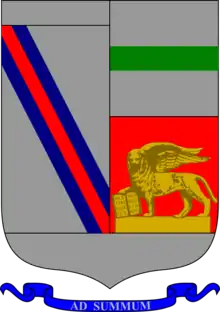38th Infantry Division Puglie
The 38th Infantry Division Puglie was a mountain infantry division of the Italian Army during World War II. The Puglie Division was mobilized 15 May 1939 and disintegrated soon after 8 September 1943. The division filled its ranks with men drafted in eastern Veneto and Friuli, with a majority of soldiers hailing from the towns of Sacile and Vittorio Veneto.[1] The only difference between line infantry divisions and mountain infantry divisions was that the latter's artillery was carried by pack mules instead of the standard horse-drawn carriages. Italy's real mountain warfare divisions were the six alpine divisions manned by the "Alpini" mountain troops.
| 38th Infantry Division Puglie | |
|---|---|
 38th Infantry Division Puglie Insignia | |
| Active | 1939–1943 |
| Country | Kingdom of Italy |
| Branch | Royal Italian Army |
| Type | Infantry |
| Size | Division |
| Garrison/HQ | Conegliano |
| Nickname(s) | Puglie |
| Engagements | World War II Invasion of Yugoslavia |
| Commanders | |
| Notable commanders | General Alberto D’Aponte |
| Insignia | |
| Identification symbol | |
| Identification symbol | Puglie Division collar insignia |
History
10 June 1940, the Puglie division was concentrated in Belluno-Feltre area. The division have received orders to transfer to Albania 3–9 February 1941.

Greco-Italian War
Arriving in Albania, the Puglie division, acting as part of Italian XIV Corps, have started to fight somewhere around Lezhë 5 March 1941. The division had only one infantry regiment attached as the 72 Puglie Infantry Regiment was assigned to the Italian XVII Corps.[2] 9 March 1941, the main body of Puglie division has assaulted the Monastery Hill (Height 731) near the hamlet of Komarak, as part of failed Italian Spring Offensive.[3] By 11 March 1941, the losses in repeated attacks were such what the division was removed from the front line and ordered to Dubrovnik for reinforcement.
Invasion of Yugoslavia
1 April 1941, the division was called to cover a Kukës – Fushë-Muhurr – Qafë-Murrë border section with between Albania and Yugoslavia. It started to advance at Blatë 7 April 1941, at Maqellarë – 9 April 1941. After breaking an initial Yugoslavian resistance, it reached Debar 11 April 1941, meeting with German forces attacking from the north. 27–28 April 1941, the units of the Puglie division have occupied Prizren, Peć and Gjakova. 1 May 1941, the additional garrisons were established at Orahovac, Štimlje and Skenderaj, all in modern Kosovo. The mopping-up and counter-insurgency operations have continued in Kosovo and to the east of it until Armistice of Cassibile 8 September 1943. Afterward, the Puglie division has moved to Albania where it soon ceased to exist under murky circumstances.
Order of battle
Notes
- Footnotes
- An Italian infantry division normally consisted of two infantry regiments (three battalions each), an artillery regiment, a mortar battalion (two companies), and an anti-tank company. A Blackshirt Legion of two battalions was sometimes attached. Each division had only about 7,000 men. The infantry and artillery regiments contained 1,650 men, the Blackshirt Legion 1,200, and each company had 150 men.[4]
- Citations
- http://www.regioesercito.it/reparti/fanteria/rediv38.htm
- "Invasion of Yugoslavia 6 April, 1941". Commando Supremo. Archived from the original on 21 May 2009. Retrieved 23 April 2009.
- John Carr, The Defence and Fall of Greece 1940–1941, page 153
- Paoletti, p 170
- "Italian Army". Axis History. Retrieved 23 April 2009.
- Paoletti, Ciro (2008). A Military History of Italy. Greenwood Publishing Group. ISBN 0-275-98505-9.